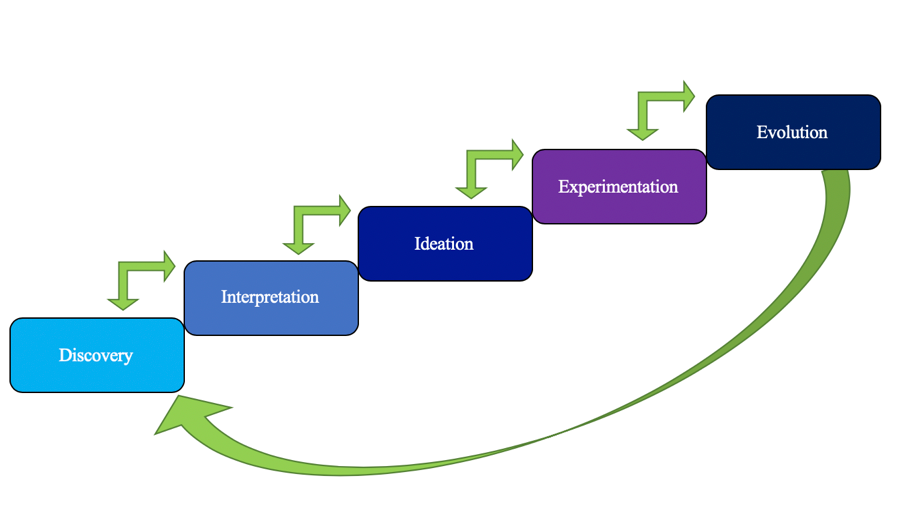The Design Process is a series of steps that engineers use to create a new prototype of a technology. Although the Design Process is relatively universally acknowledged, the names for each step can differ slightly depending on the source. For this curriculum, the handbook “Design Thinking for Educators, Second Edition” was used for information regarding the design process, and the following information in this section is from that handbook (Fierst et al. 2011).
There are five phases, or steps, of the process: discovery, interpretation, ideation, experimentation, and evolution. First, in the discovery phase, engineers are challenged to understand their problem fully and prepare research that has already been done to determine how to approach a question or a problem. Next, interpretation is exploring the meaning behind the problem. Also, in this step is the idea of understanding and empathizing with the problem, to better understand how to solve it. The next step is to ideate, to create an refine ideas to determine what to create in the next step. The forth step is to experiment and make prototypes. A large part of this step is also to gain feedback and more knowledge as iterations of the prototype is made. The last and fifth step is evolution, to use what skills and understanding was gained through the past steps to determine how to further improve the prototype and more forward with the technology.

Figure 1. Visual Representation of the Design Process.
Step 1: “Discovery” focuses on creating a whole understanding of the information and ideas provided already. It includes three subsections: understanding the challenge, preparing research, and gathering inspiration. The first of the three, understanding the challenge, involves reviewing the challenge, sharing what you know, building a team, defining an audience and refining a plan. Next, preparing research, consists of identifying sources of inspiration, selecting research participants, building a question guide, and preparing for fieldwork. Last, gather inspiration, requires one to immerse themselves in context, seek inspiration in analogous settings, learn from experts, and learn from users.
Step 2: “Interpretation” focuses on taking the ideas from the previous step and creating a clear direction for action. Like step 1, it also consists of three subsections: tell stories, search for meaning, and framing opportunities. Telling stories means capturing learnings and sharing stories learned throughout the process. Searching for meaning involves finding themes in the research and ideas gained, making sense of the findings, and defining the overall insights form all of the information provided. Last, framing opportunities consists of creating a visual reminder and making insights actionable.
Step 3: “Ideation,” means, “generating lots of ideas…its often the wild ideas that spark visionary thoughts. With careful preparation and a clear set of rules, a brainstorm session can yield hundreds of fresh ideas” (Fierst et al. 2011). This phase consists of two sections: generating ideas and refine ideas. The first, generate ideas, involves preparing and facilitating brainstorming, selecting promising ideas, and sketching to think. The second phase, refine ideas, involves doing a reality check and describing your idea.
Step 4: “Experimentation” relies on creating models and prototypes by using your ideas to create a product. It is made up of two subsections: making a prototype and then getting feedback on the product. Prototyping can involve making a mock up, a model, a diagram, an interaction or a role play. Getting feedback consists of identifying sources for feedback, selecting feedback participants, building a question guide, facilitating feedback conversations, capturing feedback learnings, integrating feedback, and identifying what is needed.
Step 5: “Evolution” revolves around next steps of continuing to grow and synthesize the idea or product. It involves two sub steps, track learnings and move forward. Track learnings is made of defining success and documenting progress, and moving forward involves panning next steps, engaging others, and building a community.